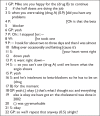Diagnosis and Decision-Making in Telemedicine
- PMID: 31853485
- PMCID: PMC6908983
- DOI: 10.1177/2374373518803617
Diagnosis and Decision-Making in Telemedicine
Abstract
This article provides an analysis of the skills that health professionals and patients employ in reaching diagnosis and decision-making in telemedicine consultations. As governmental priorities continue to emphasize patient involvement in the management of their disease, there is an increasing need to accurately capture the provider-patient interactions in clinical encounters. Drawing on conversation analysis of 10 video-mediated consultations in 3 National Health Service settings in England, this study examines the interaction between patients, General Practitioner (GPs), nurses, and consultants during diagnosis and decision-making, with the aim to identify the range of skills that participants use in the process and capture the interprofessional communication and patient involvement in the diagnosis and decision-making phases of telemedicine consultations. The analysis shows that teleconsultations enhance collaborative working among professionals and enable GPs and nurses to develop their skills and actively participate in diagnosis and decision-making by contributing primary care-specific knowledge to the consultation. However, interprofessional interaction may result in limited patient involvement in decision-making. The findings of this study can be used to inform training programs in telemedicine that focus on the development of effective skills for professionals and the provision of information to patients.
Keywords: conversation analysis; decision-making; eHealth; patient-centered care; telemedicine.
© The Author(s) 2018.
Conflict of interest statement
Declaration of Conflicting Interests: The author(s) declared no potential conflicts of interest with respect to the research, authorship, and/or publication of this article.
Figures









Similar articles
-
The opening phase of telemedicine consultations: an analysis of interaction.Soc Sci Med. 2009 Apr;68(7):1229-37. doi: 10.1016/j.socscimed.2009.01.011. Epub 2009 Feb 7. Soc Sci Med. 2009. PMID: 19201514
-
Promoting and supporting self-management for adults living in the community with physical chronic illness: A systematic review of the effectiveness and meaningfulness of the patient-practitioner encounter.JBI Libr Syst Rev. 2009;7(13):492-582. doi: 10.11124/01938924-200907130-00001. JBI Libr Syst Rev. 2009. PMID: 27819974
-
Needs of parents and professionals to improve shared decision-making in interprofessional maternity care practice: A qualitative study.Birth. 2018 Sep;45(3):245-254. doi: 10.1111/birt.12379. Epub 2018 Jul 26. Birth. 2018. PMID: 30051527
-
Risk management frameworks for human health and environmental risks.J Toxicol Environ Health B Crit Rev. 2003 Nov-Dec;6(6):569-720. doi: 10.1080/10937400390208608. J Toxicol Environ Health B Crit Rev. 2003. PMID: 14698953 Review.
-
What factors hinder the decision-making process for women with cancer and contemplating fertility preservation treatment?Hum Reprod Update. 2017 Jul 1;23(4):433-457. doi: 10.1093/humupd/dmx009. Hum Reprod Update. 2017. PMID: 28510760 Review.
Cited by
-
Experiences of telehealth in general practice in Australia: research protocol for a mixed-methods study.BJGP Open. 2022 Mar 22;6(1):BJGPO.2021.0187. doi: 10.3399/BJGPO.2021.0187. Print 2022 Mar. BJGP Open. 2022. PMID: 34880033 Free PMC article.
-
Clinician and patient experiences with shared decision-making to promote daily arm use for individuals with chronic stroke: an exploratory qualitative study.Front Rehabil Sci. 2024 Sep 19;5:1414878. doi: 10.3389/fresc.2024.1414878. eCollection 2024. Front Rehabil Sci. 2024. PMID: 39363988 Free PMC article.
-
The association between video or telephone telemedicine visit type and orders in primary care.BMC Med Inform Decis Mak. 2022 Nov 19;22(1):302. doi: 10.1186/s12911-022-02040-z. BMC Med Inform Decis Mak. 2022. PMID: 36403030 Free PMC article.
-
Factors correlating to decisions for prescribing pharmacological treatment and referrals in suspected peripheral neuropathy cases in chat consultation-based application.Heliyon. 2024 May 4;10(10):e30713. doi: 10.1016/j.heliyon.2024.e30713. eCollection 2024 May 30. Heliyon. 2024. PMID: 38803849 Free PMC article.
-
Effects of Telerehabilitation on Patient Adherence to a Rehabilitation Plan: Protocol for a Mixed Methods Trial.JMIR Res Protoc. 2021 Oct 28;10(10):e32134. doi: 10.2196/32134. JMIR Res Protoc. 2021. PMID: 34709196 Free PMC article.
References
-
- Barlow J, Bayer S, Curry R. Implementing complex innovations in fluid multi-stakeholder environments: experiences of ‘telecare’. Technovation. 2006;26:396–406.
-
- May C, Harrison R, MacFarlane A, Mair F, Wallace P. Why do telemedicine systems fail to normalise as stable models of service delivery? J Telemed Telecare. 2003;9:S25–6. - PubMed
-
- Broens THF, Huis in’t Veld MA, Vollenbroek-Hutten MMR, Hermens HJ, van Halteren AT, Nieuwenhuis LJM. Determinants of successful telemedicine implementations: a literature study. J Telemed Telecare. 2007;13:303–9. - PubMed
-
- Miller EA. The technical and interpersonal aspects of telemedicine: effects on doctor-patient communication. J Telemed Telecare. 2003;9:1–7. - PubMed
LinkOut - more resources
Full Text Sources
Research Materials

